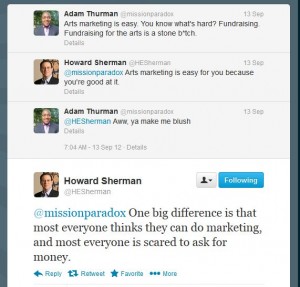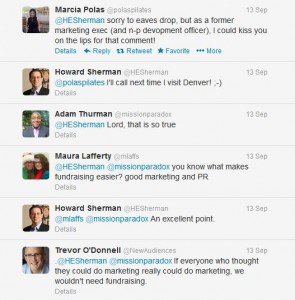There was a Slate article today covering research on motivating employees that seemed well-aligned with the non-profit work environment. The research essentially verifies the importance of providing recognition and a sense of meaning to employees.
Researchers found that small gifts, rather than money, motivated people to work harder. They told one group of workers they would receive 7 euros more in pay than they had been promised when they were recruited. Another group was given a gift wrapped water bottle worth 7 euros and the control group was given no bonus. The cash bonus didn’t inspire any improvement, but those receiving the bottle were 25% more productive than those in the other two groups. The article notes that this increase in productivity more than paid for the 7 euro expenditure.
(my emphasis)
It’s not that the workers particularly loved their bottles—in fact, in a separate experiment in which catalogers were offered the choice between a bottle versus 7 euros, 80 percent took the cash (and still worked a lot harder). Rather, it was the thought that counted, and simply handing out a few more euros hardly takes much thought. Even offering the option of a gift showed that the employer cared.
An intriguing final version of the experiment underscored the importance, in the eyes of the employees, of the thought and effort bosses put into their gifts. This time, the cash was delivered as a 5-euro note folded into an origami shirt and a 2-euro coin with a smiley face painted on it. The origami money-gift generated the highest increase in productivity of all…
The study isn’t without its limitations. It’s hard to imagine that the average Wall Street trader would work harder for a pink Cadillac than a six-figure bonus. The motivational effects of cash surely become more important when the stakes get higher, and gifts probably work best when tailored to the particular set of employees. That’s how you really show you care.
And that, more than gifts versus cash, is really the study’s takeaway. Many employees toiling away in stores, factories, and cubicles are desperate for a sense of meaning in their work lives. Even the smallest gesture of kindness that shows they’re part of an organization that actually cares can give them purpose—and that leads to motivation.
It is widely recognized that people who work in non-profits do so because they valued the purpose and meaning they find in their work. Invoking the obvious disclaimer that it shouldn’t be a substitute for paying people a living wage, a boss providing some validation that what motivates that employee is valued and recognized can keep that person energized.
It probably isn’t a coincidence that the gifts that exhibited the most effort on the bosses’ part elicited the strongest effort on the employees’ part. For all the technology that may separate us, the work environment is still a communal experience and each person wants to know that the others are expending effort and thought on their behalf.
In many respects, this goes back to the post I made last week about the early warning signs that things are amiss with your company. When the board, upper management and lower echelons are each convinced the others are invested and working hard to keep the organization viable, that knowledge permeates that whole organization without anyone giving voice to that fact.
And the absence of that unity will begin to manifest itself in some intangible way as well.





There is another way. The Gewandhaus Leipzig in Germany (concert venue) offers flex- tickets for a small premium. Not an…